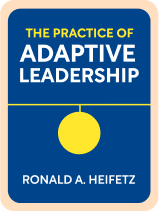

This article is an excerpt from the Shortform book guide to "The Practice of Adaptive Leadership" by Ronald A. Heifetz. Shortform has the world's best summaries and analyses of books you should be reading.
Like this article? Sign up for a free trial here .
What is The Practice of Adaptive Leadership about? What are the key takeaways?
In their book The Practice of Adaptive Leadership, leadership experts Ronald A. Heifetz, Alexander Grashow, and Marty Linsky teach you how to lead your organization through the difficult, uncomfortable, and sometimes dangerous process of adaptation. You’ll learn how to diagnose adaptive challenges, create effective interventions, and push your organization—and yourself—further than you ever thought possible.
Below is a brief overview of the key points.
The Practice of Adaptive Leadership: Tools and Tactics for Changing Your Organization and the World
There are two kinds of problems organizations face today:
- Those with known solutions that only require the application of existing knowledge and workflows to solve.
- Those with unknown solutions that require innovation, experimentation, and adaptation to survive.
The Practice of Adaptive Leadership is a book that will teach you how to deal with the second kind of problem—solving problems with unknown solutions. These problems problems are called “adaptive challenges.” The only way to solve them is for the people in organizations to learn and change. Adaptive challenges have the following qualities:
- Loss. To move forward, old ways have to be left behind.
- Resistance. People resist change because they fear the loss that comes with it.
- Discomfort. Since the solution is unknown, addressing adaptive challenges involves experimentation, iteration, failure, disorientation, and conflict, all of which must often be uncomfortably endured for a long time.
Adaptive Leadership Is Dangerous
Since adaptive problems don’t have known solutions, you won’t be able to fix them by following pre-existing directions and protocols. Therefore, adaptive leadership is dangerous—it involves challenging the expectations of the very people who gave you power.
For example, if a company hired you to run a department, they’ll want you to follow their directions and run the department in the way they expect. They’ll expect you to stay within your scope of authority and defer to them, even if this isn’t effective. Thus, changing your leadership style to face an adaptive challenge may upset your superiors.
Practice Adaptive Leadership to Achieve a Purpose
Since adaptive leadership will make people resist you and potentially jeopardize your job, it’s only worth practicing when it will help you or your organization achieve a purpose—a cause that brings you or your organization meaning and that you value. To determine what your or your organization’s purpose is:
- Assess actions rather than words. What you do is a better indicator of what you value than what you say.
- Consider what you or your organization is willing to take risks to do. If you’re willing to take a risk for something, this suggests you value it.
- Ask yourself or your organization what you’re ultimately trying to do. Then, descend a level of abstraction until you reach a concrete purpose. (Shortform example: If your ultimate goal is to “save the planet,” ask yourself what action you could take to do that—perhaps you might start a company that builds electric cars, and your purpose becomes to sell a lot of electric cars.)
Diagnosis
You can diagnose adaptive challenges within your organization by:
- Assessing the adaptive capacity of your organization and the people within it
- Assessing your own adaptive leadership abilities
- Assessing the specific adaptive challenges you and your organization are facing
These assessments will help you understand the scope of the problem and the resources you have available (or can acquire) to address it.
Assess Your Organization
There are five characteristics to consider when assessing an organization’s adaptive capacity:
Characteristic #1: Sector membership. Consider what sector (not-for-profit, private, public) your organization belongs to and how this affects its adaptability. For example, private sector organizations are usually driven by profit and competition, and like to stick with what worked in the past. Sticking to the past doesn’t help them adapt.
Characteristic #2: Formal structure. Consider how your organization’s formal structures, such as the organizational chart, encourage or discourage adaptability, both implicitly and explicitly.
Characteristic #3: Culture. Consider how myths, practices, norms, and conventions (especially in meetings) govern people’s behavior and encourage or discourage adaptability.
Characteristic #4: Habits. Consider the default perspectives and behaviors the people in your organization take and how these affect its ability to change.
Characteristic #5: Politics. Consider how everyone in your organization relates to each other, both formally and informally, and how this affects their openness to adaptive change. When faced with an adaptive challenge, what’s at stake for everyone, what’s their preferred outcome, what are they loyal to, what are their values, and how much power do they have? Do these factors help or hinder people’s adaptability?
Assess Yourself
There are four characteristics to consider when assessing your leadership abilities and capacity for adaptation:
Characteristic #1: Psychology. Consider your background, culture, experiences, loyalties, values, pet peeves, and triggers. Consider how these factors impact how adaptable you are.
Characteristic #2: Repertoire. Consider the strategies you use to effect change in yourself and others. The more varied your approaches, the better your chances of success because you can be effective in more contexts.
Characteristic #3: Roles. Consider your multiple selves and the roles you play, and how these help or hinder your ability to lead others or yourself through adaptation. (Shortform example: In some groups, you may represent level-headedness; in others, ambition.)
Characteristic #4: Authority. Consider who gives you both formal and informal authority, and what the boundaries of that authority are. How does the scope of your authority contribute to your leadership and adaptation abilities?
Assess the Challenge
There’s a two-step process for assessing adaptive challenges:
Step #1: Determine the Problem Type
The most common reason change initiatives fail is because they attempt to apply a technical solution to an adaptive problem. Therefore, the first step when approaching a problem is to determine if it’s technical or adaptive. If the problem falls into any of the following archetypes, it’s probably adaptive:
- Contradiction between people’s actions and words. For example, during the civil rights movement, many Americans spoke about valuing equal opportunity but didn’t challenge segregation when they encountered it in daily life.
- Conflicting priorities. For example, a start-up might need employees to work long hours but also value its employees’ work-life balance and want them to be able to go home and spend time with their families.
- Filtering: when people keep their potentially inflammatory thoughts and impressions to themselves. For example, employees may only bring up ideas they know their boss will agree with, instead of ideas they think will be most helpful to the business.
- Work avoidance. Because adaptive problems are hard to solve, often people want to avoid dealing with them—for example, they might blame the messenger rather than address the message. Sometimes, it’s easier to see work avoidance techniques than an adaptive problem, so if you notice them, you can work backward to figure out what the problem is.
Step #2: Articulate the Challenge
Once you’ve determined that you’re dealing with an adaptive challenge and not a technical problem, ask yourself the following questions to get a handle on the scope of the problem:
- What group is facing the challenge? What is the mission of that group?
- Is the challenge based on external changes (for example, changing market conditions) or internal changes (for example, changing company values)?
- What do I think and assume about the challenge? Are my assumptions limiting me? (Shortform example: If the problem involves conflict between two people, you might assume a personality clash. In reality, there are many reasons for conflict, and if you only consider one, you’re limiting your ability to see the whole picture.)
- What fixes have I tried, and how did they work? What fixes have I thought of that I haven’t tried, and why haven’t I tried them? What fixes am I avoiding even thinking about?
- Where are people running into conflict? Do they disagree about the mission or values of the group, about strategy and goals, or about tasks?
Treatment
Here are some tips for launching initiatives to address diagnosed adaptive challenges:
Tip #1: Help Other People Interpret the Challenge
Organizations, teams, and individuals often default to interpretations of problems that don’t require change or for them to take responsibility. Default interpretations aren’t always wrong, but they usually don’t capture the full picture. As an adaptive leader, part of your job is to shift people’s interpretations towards what’s most accurate, not what’s easiest to swallow. To push yourself and others to do this:
- Encourage multiple interpretations of the challenge by asking what-if questions and seeking multiple perspectives.
- Call people out if they regress to easy interpretations.
Tip #2: Harness Political Power
The more political power, particularly informal authority, you have, the less you’ll have to subvert expectations, and the safer your adaptive leadership journey will be. To increase your political clout:
- Increase your informal authority by bolstering your relationships with people, gaining credibility by achieving small successes, and helping people with their problems.
- Recruit allies by teaming up with people who will benefit from your intervention, have the same values as you, have non-conflicting interests, owe you, or have a history with you.
- Warn senior leaders about the chaos you’re about to unleash. Then, when people complain, the leaders won’t be tempted to remove you because they’re prepared for sabotage attempts.
- Empathize with the opposition and accept responsibility for casualties (people who will be harmed) by the change. This will make people less hostile and show that you’re accountable for causing them harm.
- Listen to the troublemakers (the people who are always negative, critical, and so on). They’re often irritating, but they’re also early-warning systems and they’re not afraid to ask hard questions that might help you address adaptive change.
Tip #3: Surface Conflict
Surfacing conflict is a way to reveal unarticulated and unacknowledged differences in values and points of view. It won’t be possible to solve an adaptive challenge until this information comes to light and people understand the challenge’s underlying issues. There’s an eight-step process to surfacing and getting through conflict:
1. Do your research on people involved in the conflict. Before bringing up the conflict, talk to all the parties involved, find out their political alignment, and develop informal authority with them using the techniques described above.
2. Set the scene. Create an agenda for the meeting in which you’ll announce the conflict and come up with rules that help people feel safe (for example, expectations of confidentiality).
3. In the meeting, invite people to state their perspectives. Ask everyone for their opinion on the adaptive challenge and to state their values.
4. State the conflict. Articulate the differences between the values everyone has just stated. This is when people will start to get uncomfortable because they realize conflict exists and someone will lose. If the participants try to avoid conflict, keep it at the forefront. Regularly remind people what you’re all trying to do by working through the conflict—make a necessary adaptive change for the better.
5. Encourage reflection on loss. Ask everyone to think about how the losses they and others might suffer will affect them and the people they represent. You can give them anywhere between hours and months to reflect on and come to terms with their losses.
6. Establish experiments. With the help of the group, come up with experiments for both managing the adaptive change and for handling casualties.
7. Set up peer consulting. Parties should share what they learn from experimenting so they can learn from each other’s difficulties. The goal is to get everyone working together, regardless of which side of the conflict they were originally on.
8. Don’t judge people for their reasons for ultimately agreeing to your initiative. Your goal is to make an adaptive change, not to make everyone pure of heart—it doesn’t matter if someone only supports your initiative for selfish reasons (Shortform example: The change harms an enemy).
Tip #4: Develop and Launch Effective Interventions
For the best chances at success, interventions should be:
- Clearly related to your interpretation. What you’re proposing must be relevant to the challenge at hand, as you’ve identified it.
- Purpose-serving. Your intervention must further the group interest.
- Unpredictable. Develop interventions that are outside your current skill set. If you always respond in the same way, people will be able to predict you and head off your efforts. (Shortform example: If, in every situation, you most value environmental protection, people can attack your change initiatives by bringing up the environmental consequences of them, knowing that this will make you doubt your initiative.)
- Experimental. Remember that addressing adaptive challenges requires openness to new ideas. You should commit to interventions while you’re carrying them out, but if they fail, be open to trying something new.
There’s a six-step launching process for interventions, and you can complete the steps individually or together in sequential order:
1. Always keep the big picture in mind. Even after you’ve started acting, maintain your diagnostic mindset so you can keep a clear head, continue to look at the situation objectively, and change course if necessary.
2. Assess how widespread the urgency to change is within the organization. If only one group is ready to deal with an adaptive challenge, your first step will be to make the issue urgent throughout the organization.
3. Decide how to frame and state your intervention. Clearly communicate the course of action and why it’s important. It must resonate with other people’s points of view, not yours, and inspire them. Use whatever mix of facts and emotions will connect to your group’s value. For example, Martin Luther King Jr. framed his dream of equality within the context of the American dream.
4. Relinquish control. Once you’ve set off an intervention, let other people discuss and change it. This creates space for other people to participate and become more invested in it.
5. Use the factions within your team as a proxy for organizational factions. As an intervention gains momentum, some people will engage with it and modify it, and others will resist it. Notice who in your team falls into each group and predict how this reflects the actions of the factions in the whole organization so you can start addressing potential resistance.
6. Keep people focused. Because adaptive work is uncomfortable, people will look for ways to avoid it at all stages of the process. Encourage them to stay on-task by (politely) calling them on work-avoidance measures like changing the subject or making a joke to defuse tension.
Tip #5: Do Regular Emotional Maintenance
Since addressing adaptive challenges is a long, experimental process, at points, people (including you) might be tempted to give up. To maintain your momentum:
- Remember your purpose. You and your organization have an important reason for enduring adaptive change—remind people of it. For example, you might create a physical, public symbol of purpose (such as a photo of someone you’re trying to help by making the change) that people encounter every day.
- Inspire people. Help them see that even though things are rough during adaptive change, a better future is possible. For example, you might express your own emotions during a speech so people see how much the adaptive challenge affects you too.
- Take care of yourself. Because you’re the leader of adaptive change, if something happens to you, the intervention might fail. To keep yourself healthy, build relationships outside of work, eat well, exercise, sleep well, and practice rituals that renew your energy and mental resources (for example, take long walks).
Build an Adaptive Culture
In the previous sections, you learned how to tackle specific adaptive challenges. Now, we’ll look at how to increase your organization’s general adaptive abilities by building an adaptable culture. Here are five qualities of an adaptive organization:
1. People acknowledge problems. Everyone is allowed and even encouraged to bring up problems and ask uncomfortable questions, even of senior leaders. As a result, these organizations catch problems early, before they spiral into disasters, and adapt to solve them.
- For example, Intel is an adaptive company, and it’s common for the leaders of meetings to openly ask about elephants in the room. Then, the company can address them early.
To develop this quality at your organization:
- Lead by example. If you, as a leader, regularly acknowledge uncomfortable problems, other people will start doing it too.
- Encourage troublemakers. Contrarians aren’t afraid to ask hard questions or bring up uncomfortable problems.
2. People care about the whole organization. People still have job titles and reporting relationships, but they also feel responsible for the whole organization’s future, not just their own. This aids adaptability because adaptation requires working together across departmental lines.
- For example, Toyota is adaptive. One aspect of their company culture that encourages organization-level investment is that assembly line workers are expected to stop the line if they notice an issue that’s outside the scope of their formal role.
3. People use their brains. People are open to changing their opinions if they get new information, and people at the lower levels of the organizational chart are encouraged to come up with ideas and make decisions. The more brain power an organization can harness, the higher its capacity for adaptation. To develop this quality at your organization:
- Only do the things that no one else can do. Whenever you have to do a task or make a decision, if someone else could do it, let them.
- Tell your people that you don’t always know what to do. This forces them to pitch in.
4. People develop leaders. Hiring talented people and putting them in appropriate positions is one of the best ways to develop adaptability because a common growth limitation is the lack of good leaders. To develop leaders:
- Prepare individual professional development programs as well as regular debriefings on real-life leadership challenges.
- Make leadership training daily and part of on-the-job supervision.
- Create clear succession paths. Determine who can replace (and ideally surpass) you. Focus on their development and train them to do so while you’re still around.
5. People are committed to learning. Everyone in the organization admits there are gaps in their knowledge and takes steps to close them. Openness to learning is an ingredient for adaptability. To encourage a commitment to learning:
- Ask people at all levels of the organization to regularly reflect on adaptive change. This will help them get used to seeking out information.
- Encourage low-cost, high-learning experimentation. (Shortform example: You might try running two ads at once with different headlines and see which one performs better.) Run multiple experiments at once and reward the people who carry them out. This will help you and your organization learn quickly because it gives you lots of data about what works and what doesn’t.

———End of Preview———
Like what you just read? Read the rest of the world's best book summary and analysis of Ronald A. Heifetz's "The Practice of Adaptive Leadership" at Shortform .
Here's what you'll find in our full The Practice of Adaptive Leadership summary :
- How to deal with unknown solutions that require innovation, experimentation, and adaptation
- How to determine if a problem is technical or adaptive
- Five tips for launching initiatives to address adaptive challenges






